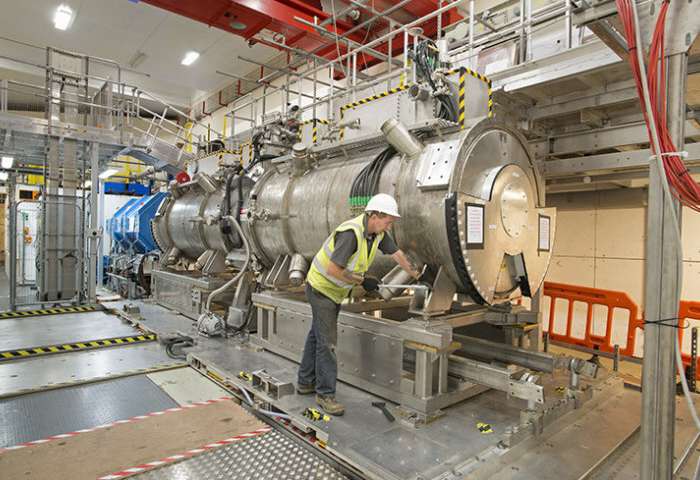One step closer to creating the most powerful particle accelerator
 Courtesy: Imperial College LondonScientists have demonstrated key technology in creating the next generation of high-energy particle accelerators.Particle accelerators are used to study the composition of substances in colliders, such as the Large Hadron Collider, as well as to analyze the chemical structure of drugs, treat cancer and make silicon microarrays.Until now, protons, electrons, and ions in concentrated beams have been accelerated particles. However, an international team called The Muon Ionization Cooling Experiment (MICE) collaboration, which includes researchers from Imperial College London, has created a muon beam.Muons are particles similar to electrons, but with a much larger mass. This means that they can be used to create beams with an energy ten times greater than that of the Large Hadron Collider.Muons can also be used to study the atomic structure of materials, as a catalyst for nuclear fusion, and in order to see through really dense materials where X-rays cannot penetrate.
Courtesy: Imperial College LondonScientists have demonstrated key technology in creating the next generation of high-energy particle accelerators.Particle accelerators are used to study the composition of substances in colliders, such as the Large Hadron Collider, as well as to analyze the chemical structure of drugs, treat cancer and make silicon microarrays.Until now, protons, electrons, and ions in concentrated beams have been accelerated particles. However, an international team called The Muon Ionization Cooling Experiment (MICE) collaboration, which includes researchers from Imperial College London, has created a muon beam.Muons are particles similar to electrons, but with a much larger mass. This means that they can be used to create beams with an energy ten times greater than that of the Large Hadron Collider.Muons can also be used to study the atomic structure of materials, as a catalyst for nuclear fusion, and in order to see through really dense materials where X-rays cannot penetrate.Decisive step success
MICE announced a successful result in creating a muon beam - driving muons into a small enough volume to make collisions more likely. The results are published in the journal Nature.The experiment was conducted using the MICE muon beam line at the ISIS Neutron and Muon Beam Council (STFC) on the Harwell campus in the UK.Professor Ken Long from the Faculty of Physics, Imperial University, acts as a representative of the experiment. He said: “The enthusiasm, dedication and intense international work, as well as the outstanding support of the laboratory staff at STFC and from institutes around the world, have made this breakthrough changing the game possible.”Muons are formed when a proton beam hits a target. Then, muons can be separated from the fragments formed on the target and directed through a series of magnetic lenses. The collected muons form a scattered cloud, so when it comes to collisions, the likelihood that they will collide with each other and create interesting physical phenomena is very small.To make the cloud less dispersed, a process called beam cooling is used. It involves the convergence of muons and their movement in one direction. However, until now, magnetic lenses could only bring the muons closer to each other or make them move in one direction, but not simultaneously.Muon cooling
During the work of Mice collaboration, a completely new method for solving this unique problem was tested - cooling muons by passing them through specially developed energy-absorbing materials. This was done when the beam was very tightly focused by powerful superconducting magnetic lenses.After cooling the beam in a denser cloud, muons can be accelerated by a conventional particle accelerator in the exact direction, which makes the collision of muons much more likely. In addition, cold muons can be slowed down so that their decay products can be studied.Dr. Chris Rogers of STFC’s ISIS, explained: “MICE has demonstrated a completely new way to compress a particle beam into a smaller volume. This technique is necessary to create a successful muon collider that could even surpass the Large Hadron Collider. "Thearticle" Demonstration of cooling by the Muon Ionization Cooling Experiment "was published in the journal Nature.Read more articles on my Telegram channel Quant (@proquantum)
Channel dedicated to physics, quantum mechanics and astrophysics.
Subscribe and expand your knowledge!
Source: https://habr.com/ru/post/undefined/
All Articles